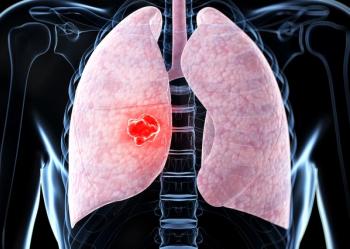
Oncology NEWS International
- Oncology NEWS International Vol 11 No 12
- Volume 11
- Issue 12
Intraoperative Lymphatic Mapping Enhances Cancer Staging
SEATTLE-Intraoperative colon-oscopy with lesion tattooing and lymphatic mapping during laparoscopic colectomy can improve accuracy in identifying a small primary colorectal neoplastic lesion and its lymphatic drainage, according to a study presented at the President’s Plenary Session of the 67th Annual Scientific Meeting of the American College of Gastroenterology (ACG abstract 4).
SEATTLEIntraoperative colon-oscopy with lesion tattooing and lymphatic mapping during laparoscopic colectomy can improve accuracy in identifying a small primary colorectal neoplastic lesion and its lymphatic drainage, according to a study presented at the President’s Plenary Session of the 67th Annual Scientific Meeting of the American College of Gastroenterology (ACG abstract 4).
The technique assisted in guiding resection and improved staging of patients with colorectal cancer, said lead author Nicholas Karyotakis, MD, an attending physician at Cedars-Sinai Medical Center, and chief scientific officer of Gastrointestinal Biosciences, Los Angeles.
"The 5-year survival for colorectal cancer has not improved all that much over the last 15 years," Dr. Karyotakis said. "The problem is that 30% of colorectal cancers at stage II tend to recur. Is that because of false-negative nodal status? We believe that direct examination of the lymph nodes of the surgical specimen may improve detection."
The main obstacle to lymph node examination is that every surgical specimen usually has 15 to 20 or more nodes that need to be meticulously dissected and examined. Dr. Karyotakis and his colleagues hope to improve upon this procedure by using lymphatic mapping to identify the sentinel nodes for closer examination.
The sentinel node is the first regional node in the lymphatic drainage pathway from the primary neoplasm, and the tumor status of the sentinel node reflects the tumor status of the nodal basin. "Sentinel lymph node mapping has been used for many years in melanoma and breast cancer, and we’re trying to use this technology in the gastrointestinal tract," Dr. Karyotakis said.
The researchers looked at 22 patients (median age, 65 years) who had small, early-stage colorectal neoplasms. The distribution of lesions by location was as follows: rectum, 2 patients (9%); left colon, 6 patients (28%); and right colon, 14 patients (63%). The median size of the lesions was 2.2 cm (range, 0.3 to 5 cm). The primary lesion was a dysplastic polyp in 4 patients (18%), stage T1 in 11 patients (50%), stage T2 in 4 patients (18%), and stage T3 in 3 patients (14%).
The study subjects all underwent intraoperative colonoscopy, with tumor site identification done laparoscopically, and efferent lymph channels tracked to the sentinel nodes using blue dye. The sentinel nodes were marked and sent to pathology along with the surgical specimen. Colonoscopy and lymphatic mapping added only about 15 minutes to the total operative time.
Standard H&E staining was used on all of the lymph nodes, and the sentinel nodes were also examined using cyto-keratin immunohistochemical staining (CK-IHC).
The accuracy of colonoscopy in identifying the primary lesion was 100%, and lymphatic mapping revealed the sentinel nodes in 91% of patients.
"Interestingly, the surgery had to be modified because of unexpected lymphatic drainage in 20% of the cases," Dr. Karyotakis said. The sentinel node was the only positive node in four patients (20%).
The direct examination of the sentinel node also resulted in the upstaging of three patients (15%) because of micro-metastases identified by CK-IHC in the sentinel node. "These are cases where we changed the actual staging that was identified by standard pathology," Dr. Karyotakis explained.
Interesting to note, he said, was the finding of a sentinel lymph node positive for metastatic malignancy in one patient with a high-grade dysplastic polyp.
Sentinel lymph node mapping may permit better identification of microme-tastases than standard methods, he concluded. Upstaged patients may then benefit from adjuvant treatments that can affect their long-term survival.
In the future, pathological microscopic examination of the sentinel nodes may include molecular biology techniques as well as immunohistochemistry, Dr. Karyotakis told ONI in an interview.
Also, he said, during the initial harvesting of the specimen, other methods of tagging or marking the sentinel lymph node involving radionuclide solutions may be used. "We have already started working on this, but the data are very preliminary and not ready to be reported," he said.
Articles in this issue
about 23 years ago
Stereotactic Radiosurgery Benefits Brain Met Patientsabout 23 years ago
Cancer Risk From Tainted Polio Vaccine Undetermined: IOM Reportabout 23 years ago
Tailored Messages Motivate Women to Get Mammogramsabout 23 years ago
Chemo/Rituximab Is Effective as First-Line CLL Therapyabout 23 years ago
Preoperative Capecitabine/RT Downstages Rectal Cancerabout 23 years ago
Rituximab Ups Survival in Aggressive and Indolent NHLabout 23 years ago
Genzyme Molecular Oncology Begins Kidney Cancer Vaccine Trialabout 23 years ago
Lower Breast Cancer Survival in Hispanics: New Mexico Studyabout 23 years ago
Concurrent Chemo/RT More Likely to Save LarynxNewsletter
Stay up to date on recent advances in the multidisciplinary approach to cancer.

















































































